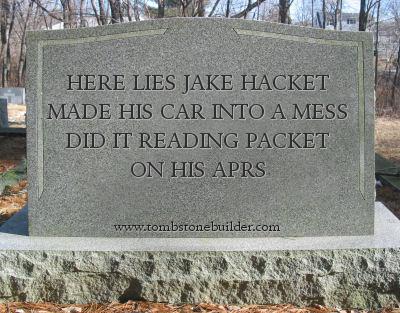Data lacking for two-way radio
At least as of several years ago, the National Safety Council in response to a letter from the ARRL said from their letter in part…
The NSC position is grounded in science. There is significant evidence that talking on cell phones while driving poses crash risk four times that of other drivers.
[. . .]
We are not aware of evidence that using amateur radios while driving has significant crash risks. We also have no evidence that using two-way radios while driving poses significant crash risks. Until such time as compelling, peer-reviewed scientific research is presented that denotes significant risks associated with the use of amateur radios, two-way radios, or other communication devices, the NSC does not support legislative bands or prohibition on their use.
This is not to say there is no risk associated with drivers using amateur or two-way radios. [. . .]
Emphasis original, not added.
Metric we can use to judge distracted driving…
Everyone agrees the time a driver’s eyes are not on the road is the problem, but how much time. Thankfully this study helps to quantify how long is too long a distraction.
Radio Tuning Effects on Visual and Driving Performance Measures – Simulator and Test Track Studies
The report dares to quantify thresholds that reach the distracted driving level.
Results of the test track radio running experiment were evaluated along with experimental data for radio tuning obtained in a driving simulator by NHTSA. Similar results were found for most eye glance measures. The data suggest the following visual demand acceptability criteria based upon driver 85th percentile radio tuning performance:
- Individual eye glances away from the forward road scene should not exceed 1.3 seconds, and
- Total eyes-off-road time to perform an entire task should not exceed 12.1 seconds.
For compatibility with occlusion testing, these time values should be rounded off to multiples of 2.0 seconds. This gives task acceptability criteria of individual eye glances away from the forward road scene not exceeding 2.0 seconds and total eyes-off-road time to perform an entire task not exceeding 12.0 seconds.
Applying to mobile operating
Every author or report writer has an axe to grind, as do we as mobile operators, but the report gives us a metric we can apply to Land Mobile Radio (LMR).
- Operate a microphone by pressing PTT on an LMR mic? Eyes stay on road = NBD.
- Fiddle with menus on an LMR radio – eyes off road – significance depends on how long eyes are off road to complete the task? Likely borderline.
- Cell hell… Mess around with cell phone menus – eyes off road – significance depends on how long eyes are off road to complete the task? Likely beyond threshold.
- Read APRS messages from the screen of a Kenwood mobile rig? Likely beyond threshold.
One can only hope our political representatives perform due diligence before making blanket assumptions about the various flavors of communicating in a car. There is an obvious difference and it is up to those proposing limitations to prove the risks with specific data. The NSC gets it. Sadly the allure of appearances to the voting block often take priority over making laws based on science.
At least the study provides an easy to measure time as a measuring stick of what constitutes distracted driving.
Safety third
Laws good or bad won’t protect you from yourself. Safety is on you.
Let’s be careful out there!

References
- Letter from the ARRL to the National Safety Council – http://www.arrl.org/attachments/view/News/53986
- Letter to the ARRL from the National Safety Council – http://www.arrl.org/attachments/view/News/53987
- Radio Tuning Effects on Visual and Driving Performance Measures – Simulator and Test Track Studies – https://vtechworks.lib.vt.edu/handle/10919/55080
I do not agree with "Everyone agrees the time a driver’s eyes are not on the road is the problem…" I believe it is the level of concentration on anything not related to driving.. Even if ones eyes are on the road, if brain is not engaged with driving, then that is distracted driving.
Perhaps I should rephrase it to "Everyone who studies and researches the issue with actual testing and/or statistical analysis agrees…"
"Even if ones eyes are on the road, if brain is not engaged with driving, then that is distracted driving." The data says otherwise.